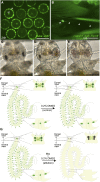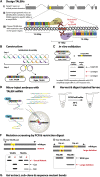Genetic and genomic tools for the marine annelid Platynereis dumerilii
- PMID: 24807110
- PMCID: PMC4012478
- DOI: 10.1534/genetics.112.148254
Genetic and genomic tools for the marine annelid Platynereis dumerilii
Abstract
The bristle worm Platynereis dumerilii displays many interesting biological characteristics. These include its reproductive timing, which is synchronized to the moon phase, its regenerative capacity that is hormonally controlled, and a slow rate of evolution, which permits analyses of ancestral genes and cell types. As a marine annelid, Platynereis is also representative of the marine ecosystem, as well as one of the three large animal subphyla, the Lophotrochozoa. Here, we provide an overview of the molecular resources, functional techniques, and behavioral assays that have recently been established for the bristle worm. This combination of tools now places Platynereis in an excellent position to advance research at the frontiers of neurobiology, chronobiology, evo-devo, and marine biology.
Figures





Similar articles
-
A genome resource for the marine annelid Platynereis spp.BMC Genomics. 2025 Jul 14;26(1):665. doi: 10.1186/s12864-025-11727-2. BMC Genomics. 2025. PMID: 40660120 Free PMC article.
-
The Nereid on the rise: Platynereis as a model system.Evodevo. 2021 Sep 27;12(1):10. doi: 10.1186/s13227-021-00180-3. Evodevo. 2021. PMID: 34579780 Free PMC article. Review.
-
PdumBase: a transcriptome database and research tool for Platynereis dumerilii and early development of other metazoans.BMC Genomics. 2018 Aug 16;19(1):618. doi: 10.1186/s12864-018-4987-0. BMC Genomics. 2018. PMID: 30115014 Free PMC article.
-
TALENs mediate efficient and heritable mutation of endogenous genes in the marine annelid Platynereis dumerilii.Genetics. 2014 May;197(1):77-89. doi: 10.1534/genetics.113.161091. Epub 2014 Mar 20. Genetics. 2014. PMID: 24653002 Free PMC article.
-
Linking micro- and macro-evolution at the cell type level: a view from the lophotrochozoan Platynereis dumerilii.Brief Funct Genomics. 2013 Sep;12(5):430-9. doi: 10.1093/bfgp/els049. Epub 2012 Nov 20. Brief Funct Genomics. 2013. PMID: 23172798 Review.
Cited by
-
Microalgal biofilm induces larval settlement in the model marine worm Platynereis dumerilii.R Soc Open Sci. 2024 Sep 18;11(9):240274. doi: 10.1098/rsos.240274. eCollection 2024 Sep. R Soc Open Sci. 2024. PMID: 39295916 Free PMC article.
-
A scalable culturing system for the marine annelid Platynereis dumerilii.PLoS One. 2019 Dec 5;14(12):e0226156. doi: 10.1371/journal.pone.0226156. eCollection 2019. PLoS One. 2019. PMID: 31805142 Free PMC article.
-
A genome resource for the marine annelid Platynereis spp.BMC Genomics. 2025 Jul 14;26(1):665. doi: 10.1186/s12864-025-11727-2. BMC Genomics. 2025. PMID: 40660120 Free PMC article.
-
The Nereid on the rise: Platynereis as a model system.Evodevo. 2021 Sep 27;12(1):10. doi: 10.1186/s13227-021-00180-3. Evodevo. 2021. PMID: 34579780 Free PMC article. Review.
-
PdumBase: a transcriptome database and research tool for Platynereis dumerilii and early development of other metazoans.BMC Genomics. 2018 Aug 16;19(1):618. doi: 10.1186/s12864-018-4987-0. BMC Genomics. 2018. PMID: 30115014 Free PMC article.
References
-
- Ackermann C., 2003. Markierung der Zelllinien im Embryo von Platynereis. Ph.D. Thesis, University of Mainz, Mainz.
-
- Ackermann C., Dorresteijn A., Fischer A., 2005. Clonal domains in postlarval Platynereis dumerilii (Annelida: Polychaeta). J. Morphol. 266: 258–280. - PubMed
-
- Aguinaldo A. M., Turbeville J. M., Linford L. S., Rivera M. C., Garey J. R., et al. , 1997. Evidence for a clade of nematodes, arthropods and other moulting animals. Nature 387: 489–493. - PubMed
-
- Arendt D., Technau U., Wittbrodt J., 2001. Evolution of the bilaterian larval foregut. Nature 409: 81–85. - PubMed
-
- Arendt D., Tessmar K., de Campos-Baptista M. I., Dorresteijn A., Wittbrodt J., 2002. Development of pigment-cup eyes in the polychaete Platynereis dumerilii and evolutionary conservation of larval eyes in Bilateria. Development 129: 1143–1154. - PubMed
Publication types
MeSH terms
Grants and funding
LinkOut - more resources
Full Text Sources
Other Literature Sources
Research Materials

